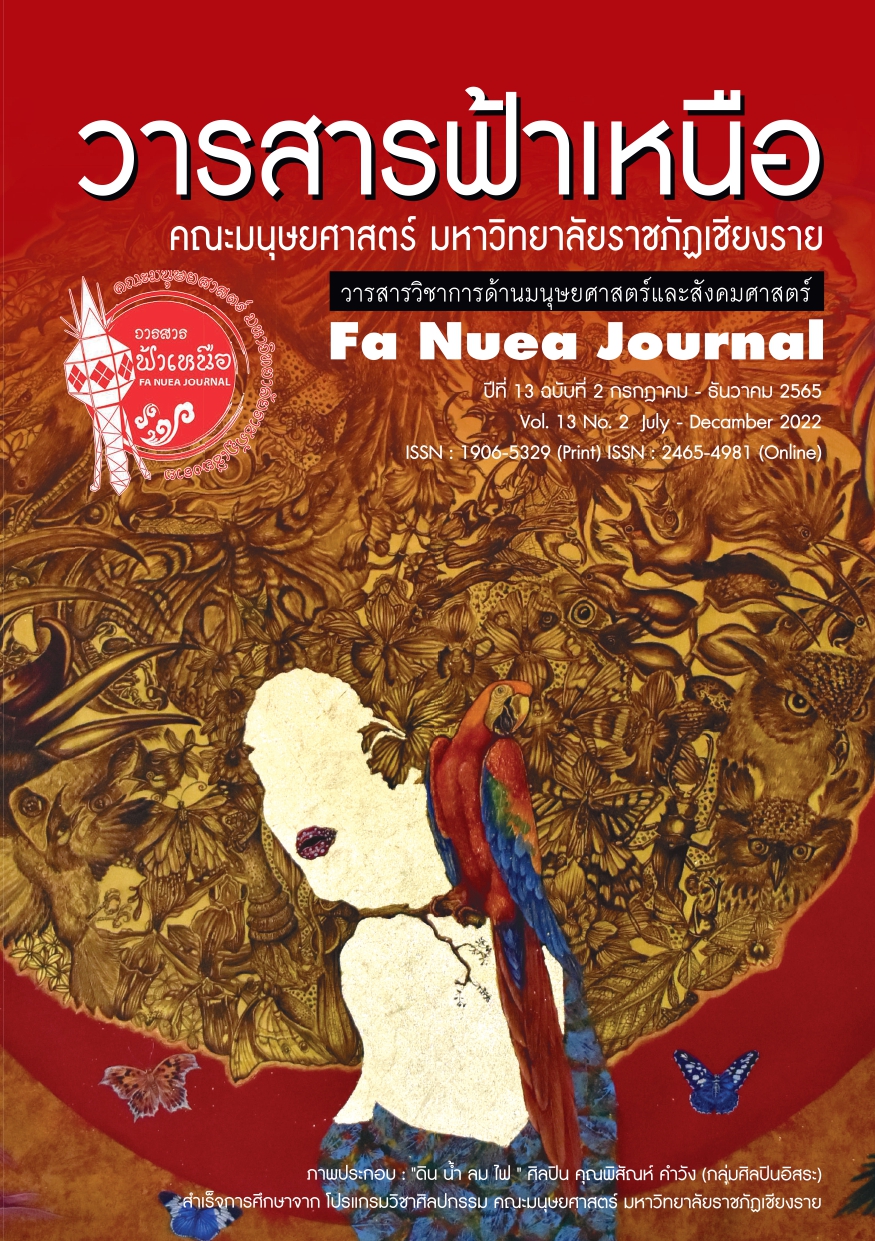Affecting Factors for Japanese Speaking Anxiety of East Asian Languages Program Students Japanese Course Chiang Rai Rajabhat University
Main Article Content
Abstract
The main objectives of the study were: (1) to investigate the factors affecting Japanese speaking anxiety among East Asian Languages Program Students in Japanese Course, Chiang Rai Rajabhat University (2) to study anxiety levels in Japanese speaking among East Asian Languages Program Students in Japanese Course, Chiang Rai Rajabhat University, and (3) to suggest the guidelines for the development of teaching and learning management in the Bachelor of Arts Program Department of East Asian Languages in Japanese Course, Chiang Rai Rajabhat University and other educational institutions. The population of the study consisted of 125 students from 1st – 4th year Admission for the academic year 2018-2021 in the Japanese Major Program, Faculty of Humanities, Chiang Rai Rajabhat University by using purposive sampling method. The instruments used in this study werethe questionnaires and semi-structured interview forms. Selection of inte rviews from people prone to anxiety. In addition, students had proposed guidelines to develop teaching and learning in the Bachelor of Arts Program of East Asian Languages Department by adding a Japanese conversation course with a native speaker in order to get used to conversation with Japanese. And in the courses, the freedom to answer questions in conversations should be more than to memorize or to check grammatical correctness. There is a need from the teacher to encourage them in their studies by using tone of voice and facial expressions to encourage students even if they make mistakes in learning Japanese.
Article Details

This work is licensed under a Creative Commons Attribution-NonCommercial-NoDerivatives 4.0 International License.
Articles, information, content, pictures, etc. which have been published in Fa Nuea Journal, are copyright of Fa Nuea Journal. If any person or party wishes to disseminate all or part of it or take any action must be referenced. Do not use for commercial purposes and do not modify (CC-BY-NC-ND). For further details, please access at Attribution-NonCommercial-NoDerivatives 4.0 International (CC BY-NC-ND 4.0)
References
เกศนีย์ มากช่วย, อามานี สามะอะ, ซีฮัม อุมา, วรเวทย์พิสิษ ยศศิริ, และ มูฮาหมัดสุ กรี หะยีสะนี. (2560). ปัจจัยที่ส่งผลต่อความวิตกกังวลในการพูดภาษาอังกฤษของนักศึกษาชั้นปีที่ 3 หลักสูตรศิลปศาสตรบัณฑิต สาขาวิชาภาษาอังกฤษ มหาวิทยาลัยราชภัฏยะลา. ใน ทัศนีย์ ประธาน (บ.ก.), พลวัตการศึกษายุคเศรษฐกิจและสังคมดิจิทัล. การประชุมหาดใหญ่วิชาการระดับชาติและนานาชาติ ครั้งที่ 9 (น. 131-143). มหาวิทยาลัยหาดใหญ่.https://www.hu.ac.th/conference/proceedings/
ทนัญชัย เยี่ยมสวัสดิ์. (2559). ความวิตกกังวลในการเรียนภาษาอังกฤษ: องค์ประกอบ ผลกระทบและแนวทางการแก้ปัญหา. วารสารสุทธิปริทัศน์, 30(95), 1-12.
ประกาย จิโรจน์กุล. (2552). การวิจัยทางการพยาบาล: แนวคิด หลักการ และวิธีปฏิบัติ (พิมพ์ครั้งที่ 2). สถาบันพระบรมราชชนก สำนักงานปลัดกระทรวงสาธารณสุข.
ประดิษฐ์ คำมุงคุณ, พระมหาสันติราษฎร์ ฌานสนฺติ (พวงมลิ), พระมหาวราสายะ วราสยานน์, พระมหาศรัญย์วัตร์กิตฺติวชิโร (อินลม), และ สมโภชน์ โว้วงษ์. (2562). ความวิตกกังวลในการพูดภาษาอังกฤษของนักศึกษาชั้นปีที่ 1 มหาวิทยาลัยมหามกุฏราชวิทยาลัย วิทยาเขตล้านนา. วารสารมหาจุฬานาครทรรศน์, 6(10), 5860-5875.
พิมลมาศ เกตุฉาย. (2562). ปัจจัยที่ส่งผลต่อความวิตกกังวลในการพูดภาษาอังกฤษเพื่อการสื่อสารกับครูผู้สอนภาษาอังกฤษที่ เป็นเจ้าของภาษา: กรณีนักศึกษาระดับประกาศนียบัตรวิชาชีพชั้นสูงปีที่ 2 วิทยาลัยเทคนิคสัตหีบ [วิทยานิพนธ์ปริญญามหาบัณฑิต ไม่ได้ตีพิมพ์]. มหาวิทยาลัยบูรพา.
เมธิณี โอคอนเนอร์. (2559). ความวิตกกังวลในการพูดภาษาอังกฤษของนักเรียนหลักสูตร ภาษาอังกฤษชั้นมัธยมศึกษาปีที่ 3 โรงเรียนบุรีรัมย์พิทยาคม [วิทยานิพนธ์ปริญญามหาบัณฑิต ไม่ได้ตีพิมพ์]. มหาวิทยาลัยราชภัฏบุรีรัมย์.
วราภรณ์ วราธิพร, สายัณห์ วงศ์สุรินทร์, อรนุช สมประสิทธิ์, ภัทรพรรณ พรหมคช และ พูนพชร ทัศนะ. (2562). การศึกษาความวิตกกังวลในการพูดภาษาอังกฤษ ของนักศึกษาชั้นปีที่ 2 คณะครุศาสตร์ มหาวิทยาลัยราชภัฏวไลยอลงกรณ์ ในพระบรมราชูปถัมภ์. วารสารวิชาการหลักสูตรและการสอน มหาวิทยาลัยราชภัฏสกลนคร, 11(30), 119-124.
ศิริวรรณ มุนินทรวงศ์. (2561). ปัญหาการฝึกงานและทักษะในการทำงานของนักศึกษาสาขาวิชาภาษาญี่ปุ่น มหาวิทยาลัยธรรมศาสตร์. วารสารเครือข่ายญี่ปุ่นศึกษา, 8(3), 206-218.
หอการค้าญี่ปุ่น-กรุงเทพฯ. (2564, 10 กันยายน). แนะนำหอการค้าญี่ปุ่น-กรุงเทพฯ. หอการค้าญี่ปุ่น-กรุงเทพฯ. https://www.jcc.or.th/th/site/index
อมรรัตน์ มะโนบาล และ เตวิช เสวตไอยาราม. (2560). การศึกษาความวิตกกังวลในการเรียนรู้ภาษาญี่ปุ่นของผู้เรียนระดับต้นที่มีพื้นฐานภาษาญี่ปุ่นแตกต่างกันเรียนอยู่ในชั้นเรียนเดียวกัน. วารสารเครือข่ายญี่ปุ่นศึกษา, 7(1), 33-50.
Embassy of Japan in Thailand. (2020, November 22). 長期滞在者・永住者及び職業別在留日本人数. Embassy of Japan in Thailand. https://www.th.emb-japan.go.jp/jp/consular/zairyu06.htm
Gardner, R. C. & MacIntyre, P.D. (1993). A student's contribution to Second Language Learning: Part II, Affective Factors. Language Teaching, 26(1), 1-11.
Horwitz, E. K., Horwitz, M.B. & Cope, J. (1986). Foreign language classroom anxiety. The Modern Language Journal, 70(2), 125-132. https://www.jstor.org/stable/327317#metadata_info_tab_contents
Littlewood, W. (1984). Foreign and second language learning. Cambridge University.
MacIntyre, P. D., & Gardner, R. C. (1994). The Subtle Effects of Language Anxiety on Cognitive Processing in the Second Language. Language Learning, 44(1), 283-305. https://doi.org/10.1017/S0261444800000045
Young, D. J. (1991). Creating a low-anxiety classroom environment: What does language anxiety research suggest?. The Modern Language Journal, 75(4), 426-439.


